Pop up window exhibit – Behind The Scenes – What’s in the Warehouse
Spring 2021
While the museum remains closed for visitors due to Cover-19 restrictions, here is a look at some new acquisitions, some old favorites, and some objects that don’t fit in with the other objects on display in the Museum.
Take a look at the museum’s windows and see if you can spot these items…
These objects are on display in the windows of the Alameda Museum, 2324 Alameda Ave., February-May 2021.
Both display windows:
 Roof cresting used as fence – according to verbal history, these metal objects are from a Victorian house in the 2000 block of Alameda Avenue, then were used as a fence in front of 2036 Alameda Avenue, before being replaced by a modern fence. Permanently mounted in the window.
Roof cresting used as fence – according to verbal history, these metal objects are from a Victorian house in the 2000 block of Alameda Avenue, then were used as a fence in front of 2036 Alameda Avenue, before being replaced by a modern fence. Permanently mounted in the window.
Right-hand window:
Display of Valentine’s cards, 1900s to 1930s. Some are unmarked, some have local names of residents about whom not much is known. Donated anonymously.
 1966 framed aerial photograph. South shore land fill by the Utah Construction Company has been mostly completed – although large sections are still fallow, and Ballena Bay Isle is only a spit of sand.
1966 framed aerial photograph. South shore land fill by the Utah Construction Company has been mostly completed – although large sections are still fallow, and Ballena Bay Isle is only a spit of sand.
Left-hand window:
- Broken Victorian cane seat chair;
 one of a pair of ‘cottage’ chairs. They were owned by Mrs. Emma Crosby, whose husband Elisha was Ambassador to Guatemala under Abraham Lincoln. They were subsequently used by their daughter Leonie, whose husband served at the Electric Light Company. More on that elsewhere.
one of a pair of ‘cottage’ chairs. They were owned by Mrs. Emma Crosby, whose husband Elisha was Ambassador to Guatemala under Abraham Lincoln. They were subsequently used by their daughter Leonie, whose husband served at the Electric Light Company. More on that elsewhere.
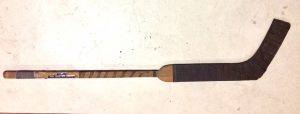
- 1931 Alameda High School hockey stick
An example of the type of equipment used in when Otto Rittler was coach at the Alameda High School. Rittler later became head of the Parks and Recreation Department. Rittler Park is named after him.
 1950s or 1960s wooden toys from the Follrath family. All wood or all metal toys. From before the ubiquitous use of plastic.
1950s or 1960s wooden toys from the Follrath family. All wood or all metal toys. From before the ubiquitous use of plastic.
- Cast-iron toys and plaster child’s hand; these toys were played with by children or grandchildren of Alameda co-founder William Worthington Chipman; the plaster hand was a project of Fannie, Chipman’s daughter, who modeled it after her niece Carol’s hand.


 Reproduction Bird-eye Map. In 1888, Daniells, editor of the semi-weekly Argus, sent out artists to sketch the houses in Alameda, block by block, to create a map from an impossible angle – as if from a mountain, or from a hot-air balloon, off the south shore of the peninsula. The three neighborhoods can be seen, Woodstock, Encinal, and Alameda. Yachts and square riggers, ferryboats and piers, chugging steam trains are visible. Some of the buildings are depicted in detail sketches around the edge, six of which still exist.
Reproduction Bird-eye Map. In 1888, Daniells, editor of the semi-weekly Argus, sent out artists to sketch the houses in Alameda, block by block, to create a map from an impossible angle – as if from a mountain, or from a hot-air balloon, off the south shore of the peninsula. The three neighborhoods can be seen, Woodstock, Encinal, and Alameda. Yachts and square riggers, ferryboats and piers, chugging steam trains are visible. Some of the buildings are depicted in detail sketches around the edge, six of which still exist.
The map has been reproduced at least twice; some copies are for sale.
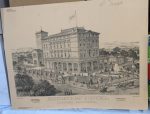 Reproduction of advertising print of the Kohlmoos Hotel. A luxury grand hotel, built in 1878 by the Kohlmoos family, corner Railroad Avenue (now Lincoln) and Linden. It was state of the art, including a bathroom on each of the four floors. After its failure as a hotel, it was run as a sanatorium, a university academy, and from 1902, the California Training Home for Girls – a boarding ‘school’ for ‘difficult’ young women. By 1920 it had become a fire-trap, and the property was donated to the City as a park. Longfellow Park now is in this space.
Reproduction of advertising print of the Kohlmoos Hotel. A luxury grand hotel, built in 1878 by the Kohlmoos family, corner Railroad Avenue (now Lincoln) and Linden. It was state of the art, including a bathroom on each of the four floors. After its failure as a hotel, it was run as a sanatorium, a university academy, and from 1902, the California Training Home for Girls – a boarding ‘school’ for ‘difficult’ young women. By 1920 it had become a fire-trap, and the property was donated to the City as a park. Longfellow Park now is in this space.
Reproduction for sale in the Museum shop.

- Wooden advertising hangers, advertising various Laundry businesses 1930s-1960s, and Walt’s Men’s Shop (1970s). Most display phone numbers starting with ALameda or LAkehurst – from a time before automated dialing based on area code was common. A time when people did not have their own washing machine, and washing was a task costing days. Note: the pile is for this window exhibit; this is not how we store these objects in the warehouse!
- Alameda Public Schools objects. This cabinet holds:
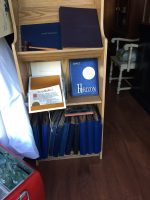
-
-
- a box with Alameda High School diplomas 1890s-1970s; many dating from before even the ‘Historic’ High School building of 1926.
- 1939-1970s PTA artifacts of various Schools (Longfellow-Webster; Haight(Love)-Sadler/Lincoln; and the Porter School PTA gavel),
- a 1965 Horizon Encinal High School Yearbook. Alameda High students’ yearbook was called the ‘Acorn’, Encinal High created the ‘Horizon’ year books. We have no copies of yearbooks of St. Josephs or Island High.
- a box with Alameda High School diplomas 1890s-1970s; many dating from before even the ‘Historic’ High School building of 1926.
-
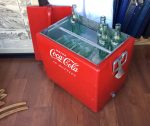 Cavalier Coca-Cola Carry-Cooler, c. 1950s. This cooler and the return bottles were owned by the Cundall / Laughlin family, who originally lived at 847 Laurel Ave.
Cavalier Coca-Cola Carry-Cooler, c. 1950s. This cooler and the return bottles were owned by the Cundall / Laughlin family, who originally lived at 847 Laurel Ave.
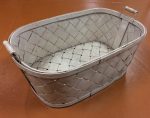 Baby basinet from Mabel Tennant’s Maternity Hospital, c. 1911-1944. This basket was used in the nursery for new born babies, at Tennant’s Maternity Hospital, 1716 Chestnut St. The building is now a home.
Baby basinet from Mabel Tennant’s Maternity Hospital, c. 1911-1944. This basket was used in the nursery for new born babies, at Tennant’s Maternity Hospital, 1716 Chestnut St. The building is now a home.
 section of floor of the original Masonic temple on Park and Alameda Avenue – the building now houses shops and a cafe.
section of floor of the original Masonic temple on Park and Alameda Avenue – the building now houses shops and a cafe.
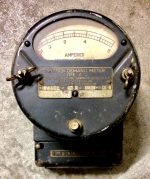 Lincoln ‘Demand’ AD2 Electrical Meter; one of many different models used over the years at the Bureau of Electricity, successor to the Alameda Electric Light Plant, and precursor to Alameda Municipal Power Co. Alameda was one of the first towns to have their own electricity plant, and remains one of the few Bay Area municipalities who don’t buy their electricity from Pacific Gas & Electricity Co.
Lincoln ‘Demand’ AD2 Electrical Meter; one of many different models used over the years at the Bureau of Electricity, successor to the Alameda Electric Light Plant, and precursor to Alameda Municipal Power Co. Alameda was one of the first towns to have their own electricity plant, and remains one of the few Bay Area municipalities who don’t buy their electricity from Pacific Gas & Electricity Co.
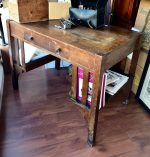 Craftsman style desk (For Sale). Craftsman was the trade name for hand-crafted furniture made by Gustav Stickley (1858-1942), advocate for the Arts and Crafts movement; the furniture is characterized by use of natural materials (wood), and limited ornamentation. This is not a Stickley, but it is for sale in the gift shop.
Craftsman style desk (For Sale). Craftsman was the trade name for hand-crafted furniture made by Gustav Stickley (1858-1942), advocate for the Arts and Crafts movement; the furniture is characterized by use of natural materials (wood), and limited ornamentation. This is not a Stickley, but it is for sale in the gift shop.
The books on the sides are for sale as well; copies of the Alameda High School centennial publication (1874-1974) and two of curator George Gunn’s books.
On the desk:
 nurse’s bag; used in the 1920s by nurses from the American Red Cross for home visits. In 1918-1919 battling the influenza epidemic was in Alameda accomplished by the local Red Cross chapter.
nurse’s bag; used in the 1920s by nurses from the American Red Cross for home visits. In 1918-1919 battling the influenza epidemic was in Alameda accomplished by the local Red Cross chapter.
- pinkie puppet with Alameda Hospital wrist band; these puppets were made by volunteers of the Alameda Hospital Auxiliary.
- red cross nurse marionette; This marionette was used by actress Doris Goodman to entertain groups of kids. Doris was, in 1938, co-founder of the Alameda Little Theater, which later found a permanent home in the Arena-like Playhouse on High Street – the initials of the original company are retained in the first three letters of the current organization: Altarena.
- box of broken pottery and glassware. Before sewage, a dump, or scheduled garbage pick-up, people threw broken stuff, food scraps, and other refuse into a hole (or pile) in their garden. The ones in this box were dug up a century later and donated; however, objects similar to these have been donated to the museum while still in one piece. What to do?
- box from Glue company. The Federal Glue Co. was briefly located at 2424 Blanding Company, sometime in the 1920s or 1930s (judging by the phone number). The ‘Monitor Prepared Paste’ was used in wallpaper hanging, laying of linoleum, etc.
behind the desk:
- miniature sewing machine; this is not a toy, but was used at the Alameda Steam Laundry (see hangers), 2215 Lincoln Ave, to darn fabric.
- green flashed glass goblet; This object was owned by the Stagnaro family – Albert Stagnaro was a stained glass / leaded glass artist.
- Nellie’s Bell; Cow bell worn c. 1870 by Nellie, owned by the Abram Rich family of 1620 4th street. Once upon a time, the long lots were vegetable gardens, as well as holding sheds and stables for livestock, chickens, and in this case, a cow.
 Broken Colored Electric Candelabra from the Masonic Lodge. The current Masonic Lodge was built to to house the Masonic order and the building on Park Street was sold; the ground floor was created as a car-parking – now leased to the Alameda Museum. Alameda had multiple lodges – Apollo Lodge (#396), Woodstock Lodge (#495), but the current Island City Lodge retains the number of the Oak Grove Lodge (#215).
Broken Colored Electric Candelabra from the Masonic Lodge. The current Masonic Lodge was built to to house the Masonic order and the building on Park Street was sold; the ground floor was created as a car-parking – now leased to the Alameda Museum. Alameda had multiple lodges – Apollo Lodge (#396), Woodstock Lodge (#495), but the current Island City Lodge retains the number of the Oak Grove Lodge (#215).

